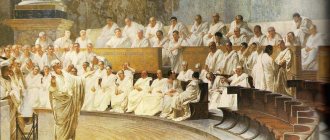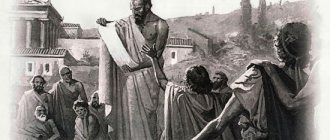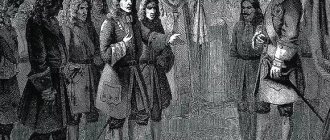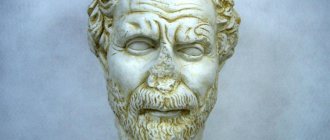Medieval rhetoric
In the Middle Ages, the status of rhetoric was retained as one of the components of trivia (this system was borrowed by the Middle Ages from antiquity). The main content of the rhetoric course was the doctrine of genres of speech, based mainly on the ideas of the ancient poet Horace, the doctrine of styles, which was developed by Virgil, as well as the doctrine of figures.
The appearance of the genre among the objects of rhetoric was not accidental, since the Middle Ages also borrowed from antiquity the idea of clear boundaries between different types of speech. In this regard, even such a section of rhetoric as invention is rethought: in the Middle Ages it is perceived not so much as a search for thoughts, but as a search for a suitable genre.
The fact that rhetoric is turning more and more towards fiction also played a role in the increasing role of style. The doctrine of styles was attributed to Virgil, who supposedly invented a “wheel” on which various styles were diagrammatically represented. At the same time, the styles were tied to certain literary works: the high style corresponded to the Aeneid, the middle style to the Georgics, and the low style to the Bucolics. Obviously, this scheme made it mandatory to focus on literary rather than oratorical texts.
features can be noted . 1. Homiletics—the art of church preaching—comes to the fore. In addition, academic eloquence also comes to the fore. Confrontational eloquence, closely associated with legal proceedings and government activities, fades into the background.
There is a significant difference between the eloquence that was formed in the Middle Ages and the eloquence of antiquity. In antiquity, rhetoric was closely connected with the need to convince, to prove what the opposite side for some reason does not want to admit. In the Middle Ages, this function of rhetoric recedes into the background. This is not to say that homiletics does not involve persuasion at all: in order to force people to follow the commandments and requirements of the church, it is necessary to explain to them why this is necessary. However, what is fundamental is that in fact, in the situation of delivering a sermon, we are not dealing with opposing points of view, but with the opposition of knowledge and ignorance, or even with a simple prescription. The relative decline in polemical eloquence significantly changed the face of rhetoric.
2. In the Middle Ages, the development of issues related to the distinction between tropes and figures, as well as the description of their varieties, continued. Poetry in the Middle Ages largely developed in the direction of mastering these figurative means. In particular, in the 15th century, the school of so-called rhetorical poets flourished, the main feature of which was the active (and conscious) use of figures and tropes and, in general, various means of increasing the semantic and aesthetic richness of the text.
However, the number of works devoted to these issues is much less than that of antiquity. One of the most striking manifestations was the work of the Venerable Bede, “The Book of Paths and Figures.” Other notable representatives of the rhetoric of the early Middle Ages include Isidore of Seville and Julius Rufinius. Another important rhetorical work of that time is the treatise “On the Paths” by the Byzantine author George Heroboscus, created in the 4th or 5th centuries AD. e. This work is important because it was translated into Russian and became part of the “Svyatoslav Collection” (1073). In fact, this treatise was the first rhetorical work translated into Russian. Although after this the problems of rhetoric did not attract the attention of Russians for a long time, it was from the moment of the appearance of “Svyatoslav’s Collection” that the history of Russian rhetoric can begin.
During the late Middle Ages, such rhetorical treatises were created as “Rhetoric” by Philip Melanchthon (translated into Russian in 1620), “Rhetorical Art” and “Rhetorical Commentary, or Instructions for Orators” by Gerhard Voss, as well as the rhetorical works of Julius Caesar Scaliger .
3. In the Middle Ages, in general, the process of “degeneration” of rhetoric continued, which from a practically oriented discipline gradually turned into a school subject, divorced from the real needs of communication. This process made itself felt most clearly during the Renaissance, when a number of very important changes took place in cultural life.
The number of VKontakte users is comparable to the population of the entire country. And it is not surprising that some groups on this social network have gained truly stunning popularity, breaking traffic records for many popular sites. Moreover, creating and promoting a VKontakte group is sometimes much easier than an offline site. But not everyone manages to quickly gain traffic and the number of subscribers in their community.
First you need to determine the target audience of the group
. Audiobooks on business are unlikely to interest schoolgirls aged 14-15, and groups with “vanilla” quotes and statuses are unlikely to attract adults. The main mistake of community administrators is that they promote groups that are not in their social network segment.
The group needs to be updated regularly
, adding unique and interesting content to users. The more often posts are added to the wall, the more loyal users will be to the group. And interesting posts may well be sent to the user’s wall using the “Tell Friends” function, which will attract an additional flow of visitors to the group.
Before advertising a group, you can create an artificial activity
.
To do this, you can register or buy 10-20 “fake” accounts
, add them to the group and develop discussions from them, comment on posts and “Like” them. Live users are very inactively added to “dead” groups, but when they see “live” activity on the wall, they add without hesitation.
You can buy subscribers to the group, as well as likes and shares on VKontakte on the following sites:
- v-like.ru
- promotion of VKontakte groups; - vkserfing.ru
- a system for active promotion and earnings on social networks; - vktarget.ru
is an advertising service on social networks, where everyone can earn money or attract a new audience.
You can add bot accounts to the group, no more than 1000 pieces. The average VKontakte user, once in a group that interests him, first of all looks at the number of participants. If there are few of them, then the user will most likely leave the group in search of a more populated community, considering it frivolous or abandoned. You can order bots to join a group on special forums and groups. It will cost about 100-200 rubles, depending on the quality of the accounts.
VKontakte has many mutual PR groups
. It is worth finding groups that agree to mutual advertising in order to attract subscribers, and agree on the terms of cooperation. However, you should immediately pay attention to the following: 1. You should not look for public pages with an audience that does not fit the theme of your community. If a group about motorcycles is developing, it is unlikely that a large number of interested subscribers will be found in groups about cosmetics and hairstyles. 2. You should not do mutual advertising at the same time. You can agree with the community administrator that advertising for his group will appear in a few posts, or even in a couple of days.
Tags
The appearance of VKontakte tags has greatly simplified the search for the necessary information, and their correct use is one of the invisible but key ways to advertise a group. If the group is about actors, you can use a tag with the actor's name above posts with photos. If the group is an online store, you can use tags such as “discounts”, “sale”, “new items”, etc. However, you should not get carried away and enter several tags at the same time - this will significantly reduce interest in the group. In order to add a tag to a post on the VKontakte website, you need to put the “#” icon, and after it write the necessary word or phrase. It is important to note that you cannot use a space in tags; you can replace it with underlining or writing words together, but using capital letters.
Another effective, but rather expensive method is ordering contextual advertising from the VKontakte website. When creating an advertising campaign, you need to come up with an enticing ad text that will reflect the theme of the group, upload a picture and set a price for clicking on the link. The higher the cost per click, the more visitors per unit of time click. And if a really interesting and high-quality group is promoted, then visitors will turn into participants.
Don't overdo it with bots. The group may be banned by the VKontakte administration if the number of bots is comparable to the number of real participants. Therefore, after at least 3000-5000 real people join the group, you need to clean up the composition and remove all participants with a gray dog on their avatar.
Helpful advice
You should not use spam as a method of promoting a group. Users can complain to the administration about an annoying ad, and the group will be automatically blocked.
Sources:
- kakprosto.ru - article “How to quickly promote a group”;
- kakprosto.ru - article “How to develop a VKontakte group for free.”
Additionally on Guenon:
- How to delete your VKontakte group?
- Who is Pavel Durov?
Development of rhetoric in the Middle Ages and the Renaissance
In the Middle Ages, the church became a legislator in all spheres of life: ideology, politics, economics. Ideas and provisions that did not fit the church canons had no right to life. In such conditions, living, free thought could not develop.
The spiritual life of society declined, which also affected the development of rhetoric. In the Middle Ages, the art of church preaching (homiletics) became the leading one. If you compare ancient eloquence with oratory in the Middle Ages, you can see a significant difference between them.
Ancient rhetoric is associated with the art of persuasion, the proof of controversial ideas. In the Middle Ages, only the external form of rhetoric was preserved. Homiletics has the art of persuasion, but preaching never involves opposing points of view on the subject of the statement; it is associated with knowledge and comprehension of church postulates, with suggestion, and not with conviction.
Interpretation of biblical myths , religious dogmas, and canons of sacred history are the main tasks of homiletics as the science of Christian church preaching. The names of the famous religious preachers of the Middle Ages, Basil the Great, John Chrysostom, and Augustine the Blessed, are world-famous. At the same time, Isidore of Seville and Bede the Venerable, author of the essay “The Book of Paths and Figures,” spoke with them.
It should be noted that poetry in the Middle Ages developed under the influence of this work. In the 14th century The school of rhetorical poets was popular. They consciously introduced figures and tropes into their poetic texts. The aesthetic and semantic side of the poem could not be imagined without the “flowers of eloquence.”
With the advent of medieval universities in the 11th-12th centuries. University eloquence is born . It was during this period that the word lecture itself arose. The Latin word legere means “to read”, lectio means “reading”. Professors gave lectures on large handwritten books with heavy bindings. Books were rare and expensive, and they were often chained to the pulpit. Only the professor had the right to read books. The scientist’s task was to comment on the text he read.
Of course, university eloquence was not free from church influence. Religious philosophy, scholasticism (from the Greek scholastikos - school, scientist) occupied a leading position in science. Church authorities served as reliable support for scholasticism.
“Holy Scripture” is the source from which the scholastics drew their evidence. At the same time, they neglected experimental data and facts. It is enough to get acquainted with the writings of the 13th century theologian. Thomas Aquinas to present the essence of scholasticism. All knowledge, according to Thomas Aquinas, is a sin, unless it has as its goal the knowledge of God.
The science of the Middle Ages could not free itself from theological postulates. Hence the unique criteria for a scientist’s erudition: knowledge of a large number of quotations, the ability to express himself in Latin. Scholastic rhetoric also found itself in the vicious circle of dogmatism, scholasticism, and church canons. Rhetoric “degenerates” and becomes a school discipline, divorced from real communication.
The Renaissance was a time of discovery of man as an individual. The humanists of the Renaissance proclaimed the “universality of man” - an ideal that distinguishes this time from the Middle Ages with its ideal of the “righteous man”, “ascetic” or “knight”. It is enough to compare the titles of works from different eras: the medieval treatise “On the Misery of the Human Condition” (1195) by Cardinal Lothair and the treatises “On the Dignity and Splendor of Man” (1452) by D. Manetti or “Speeches on the Dignity of Man” (1487) by Pico della Mirandola.
These titles speak convincingly of a completely different assessment of human capabilities. In his speech “On the Dignity of Man,” the thinker substantiates the doctrine of free will. Free will is nothing more than a manifestation of the freedom of a person’s mental and verbal ability. The author claims that philosophy and eloquence, as in ancient times, constitute an inextricable unity.
The humanistic views of the Renaissance were formed under the sign of the ideas of Plato, Aristotle, and Cicero. Renaissance humanists were convinced that the possibilities of human knowledge are limitless, that the human mind “participates in the divine mind,” and man himself “is, as it were, a mortal god.”
The successes of science, natural science, technology, art, the great scientific discoveries of the era and inventions were the reason for such humanistic optimism. During the Renaissance, such human qualities as honor, dignity, virtue, and knowledge are valued. The humanities become the main “knowledge”.
Italian humanists glorified mastery of the Greek and Latin languages and introduced them to the works of ancient authors. The literary language of the West and the international language of science in the XV-XVI centuries. becomes Latin.
The idea of renewing literature, proposed by the humanists of the Renaissance, encouraged speakers to find rhetorical possibilities in their language and to assimilate the rich experience of ancient authors. This was the time of the formation of national languages. Starting with Dante’s treatise “On Popular Eloquence,” manifestos began to appear in defense of the native language.
Ancient genres - ode, hymn, elegy and epic poem - will reign for a long time in the poetry of the Renaissance. Rhetoric can be considered the common source that feeds the entire diversity of Renaissance poetry. Classic examples of rhetorical art are the monologues of Hamlet, Juliet, and King Lear. It is important that literary prose and poetry contributed to the improvement of speech culture, increased sensitivity to the spoken word, and contributed to the development of oratorical style.
Rhetoric of the Middle Ages (general provisions and characteristics of one of the representatives).
⇐ PreviousPage 8 of 13Next ⇒Rhetoric - the science of the art of eloquence - has existed since ancient times and occupies an important place in culture, combining a rich historical tradition and practical recommendations for everyone who wants to speak beautifully, accurately and convincingly.
The main feature of the medieval era is its deep and very complex relationship with religion. In the Middle Ages, the church was the largest feudal landowner. It occupied dominant positions in economics, politics, and ideology. Religion served to justify and strengthen the feudal system. All social institutions, philosophy, science, education and art were subordinated to theology. Ideas that were not consistent with the teachings of the church were not recognized, and every living, free thought was suppressed. This slowed down and held back the development of the spiritual life of medieval society. The system of religious worldview left its mark on all the achievements of that time, including oratory.
As A.G. rightly wrote. Timofeev in his “Essays on the History of Eloquence”, “medieval eloquence could not have the creative power of true art, but it had to remain on the basis of pure rhetoric, live by one external form, in the bizarre processing of which the essence of eloquence was then seen. The orator had no place in public life.” The main type was spiritual eloquence, which became a powerful tool for the church to protect and strengthen its positions and a strong means of influencing the masses.
Church ministers had to retell church dogmas, interpret biblical legends, and educate parishioners in the spirit of humility and submission. The main method of influencing listeners is not persuasion, but suggestion. Homiletics, the science of Christian church preaching, begins to develop.
With the advent of medieval universities in the 11th – 12th centuries, university eloquence arose, which also could not develop freely from the church. The dominant position in science was occupied by scholasticism (from the Greek Scholasticos - school, scientist), religious philosophy. Its most characteristic features were the desire to rely on “authorities,” mainly church ones, and a complete disregard for experience. The scholastics drew their evidence, first of all, from the “holy scripture.”
Scholasticism found its most vivid expression in the writings of the Catholic theologian of the 13th century. Thomas Aquinas, who declared that all knowledge is sin unless it has as its goal the knowledge of God.
As the researchers note, science was in a vicious circle of authority and tradition. An important sign of scholarship was knowledge of the Latin language and the ability to use Latin words and expressions in one’s speech.
Lectures at universities were given by professors from large handwritten books in heavy bindings. There was no printing at that time, therefore, in order to preserve books, they were often chained to the pulpit. The lecturer's task was for students to comment on the text they read.
Dogmatism, quotation, scolding, as well as the pursuit of external form and playing with logical concepts become the main techniques of scholastic rhetoric.
In a theoretical sense, medieval rhetoric adds almost nothing to ancient developments; it adheres to the rules of Aristotle and later theorists (in the West - Cicero) and only reworks them with a view primarily to writing letters (epistles) and sermons. Everywhere there is a tightening of requirements for compliance with these rules.
Already by the 4th century, the scope of rhetorical norms coincided with the very concept of literature: in the Latin literature of the Middle Ages, rhetoric replaced poetics, firmly forgotten by the medieval tradition.
The creation of the work, in turn, was divided into three parts or stages (three main elements out of five in the ancient list).
1. Invention (lat. inventio), is actually the discovery of ideas as a creative process. She extracts from the subject all its ideological potential. It presupposes that the author has the appropriate talent, but in itself is a purely technical device
2. Disposition (lat. dispositio), a prescription for the order of arrangement of parts. Medieval rhetoric never seriously dealt with the problem of the organic combination of parts. It is limited to a few empirical and general prescriptions, defining a certain aesthetic ideal rather than ways to achieve it.
3. Elocution (lat. elocutio), puts “ideas” into linguistic form. It served as a kind of normative stylistics and was divided into a number of parts; The most developed of them is the one devoted to decoration, the decorated syllable, that is, mainly the theory of rhetorical figures.
Assessing the state of rhetoric in the Middle Ages, it must be said that it suffers from the same main defect as the ancient one. Her recipes do not give a natural effect in practice. “Conscientious disciples” still ask: why success is achieved only by a very talented or very cunning speaker (they could do without rhetoric!), while ordinary honest people (even with its help) cannot captivate their listeners . However, in this era, the authority of rhetoric is still high: life does not make particularly great demands on it, because in place of the ancient world, which knew primarily confrontational, judicial and parliamentary eloquence, not associated with the opposition of communicative attitudes, but having a predominantly communicative or informational nature, rhetoric is increasingly dissolved in the art of preaching - homiletics, and, naturally, its authority is supported by the powerful authority of the church.
2. John Chrysostom (347 – 407)
One of the greatest early Byzantine writers was John Chrysostom, who, like many of his contemporaries, organically combined in himself an ancient rhetorician and a Christian theologian.
Chrysostom was born and raised in the Syrian city of Antioch, a major cultural center of the Eastern Roman Empire, where the traditions of various peoples crossed. Chrysostom's mother Anfusa was the most enlightened woman of the era; she gave her son an excellent education at home. John studied rhetoric at the school of the famous orator Libanius (314 - about 393). Chrysostom spent a short time as a lawyer, which allowed him to study in detail the customs and customs of the Antiochian world, which he became familiar with due to his occupation.
Upon returning to Antioch, John was ordained deacon in 381 and began preaching, gathering a large audience. In 398, Chrysostom was appointed Archbishop of Constantinople.
His accusatory sermons and calls for a modest lifestyle aroused the hatred of the court and wealthy citizens. Harshness, intolerance, belligerence - important character traits of Chrysostom, perfectly felt in the tense language of his speeches, also played their role. John expressed a negative attitude towards the then widespread slavery, which he considered the fruit of violence, wars and sin.
On the way to his final exile, John dies. Among Byzantine connoisseurs of eloquence, John Chrysostom became famous as a master of words, and in the Orthodox Church his authority as a saint and interpreter of the Holy Scriptures is unusually great. 100 years after his death, this church writer received the nickname Chrysostom (in Greek, Chrysostom). In rhetorical schools, it was assigned only to those who had perfectly mastered all the subtleties of constructing and verbally finishing speeches, as well as the art of delivering them.
3. Bede the Venerable (673 – 735)
He was born near the monastery of Wearmouth, was fostered there at the age of seven, was transferred to the neighboring monastery of Jarrow shortly after its foundation in 691, and there became a monk. Around 692 he was ordained a deacon, and in 703 a priest. He is known to have visited the monastery at Lindisfarne and may have traveled as far as York. However, in his own words, he spent his entire life in Jarrow. He wrote: “Having devoted all the time of my life to this monastery, I completely devoted myself to the study of the Holy Scriptures and, observing the monastic rule and daily services in the temple, I always found joy in learning myself, teaching others and writing.”
Bede as a writer and historian has, perhaps, many prototypes and followers, but has no analogue in Western European culture. The figure of Bada to this day towers over many of his predecessors and students, attracting attention with his unique originality.
Bede owns about forty works, which together form something of an encyclopedia. Twenty-five of them contain biblical commentaries, covering most of the books of the Old and New Testaments, as well as the Apocrypha. The rest include the lives of saints and martyrs.
Beda died on the eve of the Feast of the Ascension of the Lord, when Vespers was served. There is evidence that not so long ago his cult existed in England. Not far from his birthplace in Mancton there is the “Beda’s well”, considered miraculous, where until the end of the 18th century. local residents brought sick children for healing.
The last title, assigned to Baeda shortly after his death, is usually translated as Venerable (Baeda Venerabilis), but it may also have another translation, which, in our opinion, sounds more natural in Russian - Rev.
⇐ Previous8Next ⇒
Site search:






